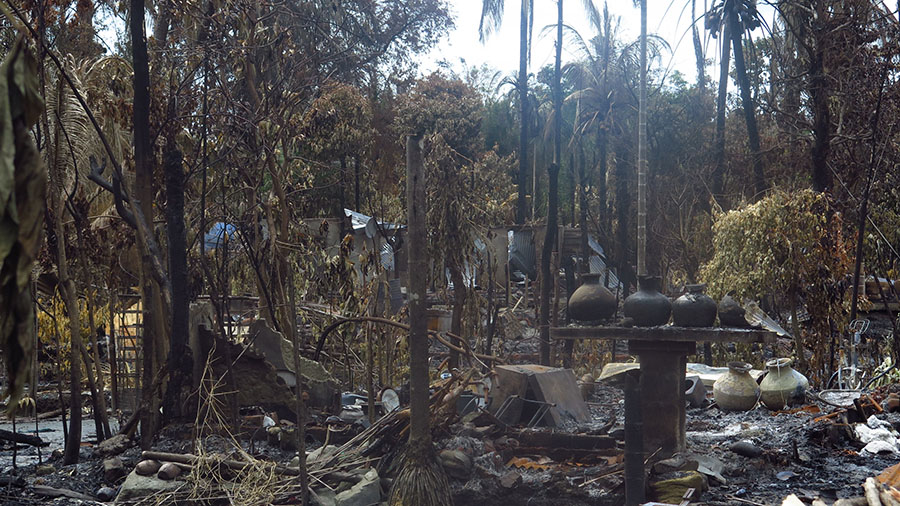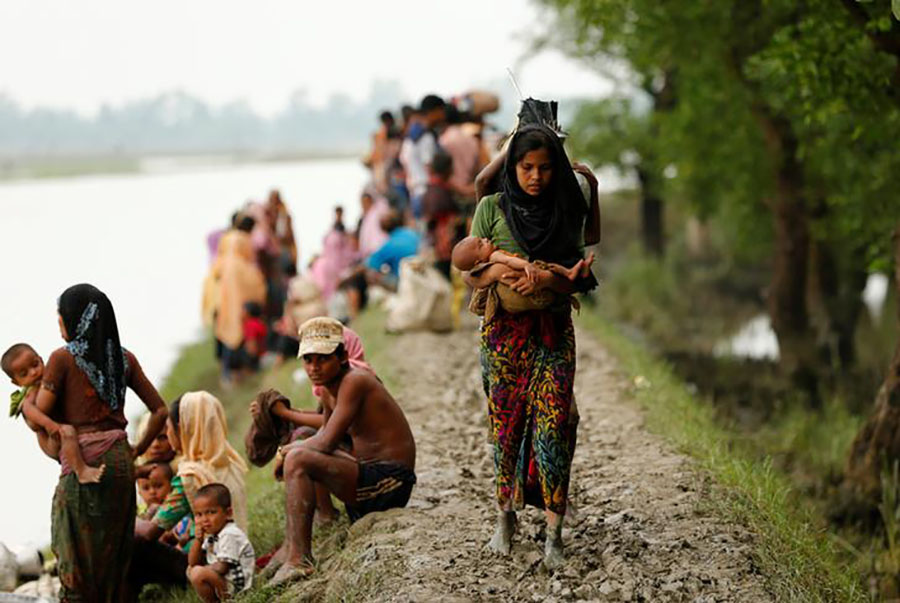SITTWE, Rakhine State – I was among the 22 journalists from local and international news publications who arrived Buthidaung Township in the afternoon on August 30. We were met by news that four young Arakanese had been killed by Muslim militants in Zula village in neighboring Maungdaw Township, and that clashes were ongoing with government security forces.
The police escorted us 24 kilometers down a road linking Buthidaung and Maungdaw, crossing through the green Mayu mountain range. We saw very few cars or bikes. After nearly one hour, we reached Tha Si village, three miles from the border checkpoint where several thousand internally displaced Arakanese people (IDPs) shelter.
A couple minutes’ drive from Tha Si village, we reached Myo Thu Gyi village, a Muslim community of 8,600 residents located on the highway, only 1.6 kilometers from the entrance of Maungdaw town, where there is a police checkpoint.
The village has been reduced to a heap of ash. It was the worst scene I have witnessed in recent years. Myo Thu Gyi had been spared following clearance operations after last year’s October 9 attacks, in which tens of thousands of Muslims fled across the Bangladeshi border to Teknaf District.


Rising Death Toll
According to the latest information from the government, since the August 25 attacks by the Arakan Rohingya Salvation Army (ARSA) on police outposts, its members killed 14 Arakanese Buddhists, seven Hindus and seven Muslims, as well as 15 members of government security forces, and three civil servants.
Security forces have killed 371 suspected militants and apprehended 38 suspects since late August. There has been criticism from the international community regarding the discrepancy between the death toll and the weapons seized by the authorities—a few assault rifles and homemade guns, as well as swords, darts and knives.
During the two-day trip to Maungdaw, displaced Arakanese and Hindu residents and government officials told reporters that at least 100 people were involved in attacks on them, mostly carried out with swords, machetes, slingshots and daggers—few of them had guns, they said.

Some security forces who have been receiving medical treatment in Sittwe hospital said attackers opened fire on police and then marched forward, and the police decided to shoot into the crowd. Otherwise, they said, they would have been killed on the spot.
A police major told The Irrawaddy that if a Muslim targeted for recruitment by ARSA refused to be involved, they were often killed. He also alleged local religious leaders had played a role in recruitment—a claim which The Irrawaddy could not verify.
Maungdaw Township administrative official U Ye Htut revealed an intelligence report that the ARSA had already recruited at least 100 members throughout Maungdaw. He also told reporters that the rest of the people—namely, women and children—involved in the attacks against security forces or civilians would be recognized as “terrorists” and dealt with as such.
With a death toll of nearly 400 suspected militants is highly possible that many of them would not have used firearms and applied as human shield to fight against government troops in the battle.

Reuters has discovered that ARSA leader Ata Ullah delivered a voice message to his supporters ordering the launch of an offensive against government border outposts last month. It occurred hours after the release of the Kofi Annan-led Advisory Commission on Rakhine State’s final report on August 24.
The message stated, “if 200 or 300 people come out, 50 will die. God willing, the remaining 150 can kill them with knives.”
Complexity
According to an update from the Government Information Committee this week, 6,845 houses in 60 villages have been burned down. The government said the fires were set by the ARSA, while militants cite the army as being responsible. The Irrawaddy was told by many sources from the Hindu, Buddhist Arakanese and Muslim communities that arson has been carried out by both sides.
This Irrawaddy reporter asked to stay one more night in the conflict-area to collect further information, but the request was refused by the authorities.
Human Rights Watch (HRW) has released satellite images showing the destruction of 17 villages populated by self-identifying Rohingya. International rights groups have again accused the Myanmar Army of committing arson during military operations.
More than 26,700 Arakanese Buddhists and Hindus have been displaced and evacuated to 33 locations in Maungdaw, according to government figures.

The UN has stated that 146,000 Muslims have fled to Bangladesh and are living in makeshift shelters. Some of those fleeing are confronted with landmines along roads, and a lack of access to aid in temporary relief camps.
Burdens and Barriers
During a three-day trip to Rakhine, I documented several witnesses’ accounts, including those from internally displaced persons who were Hindu, Arakanese and belonging to the Arakanese sub-ethnicities.
But the government’s guided tour did not allow us to meet with Muslim IDPs and those who had lost their homes elsewhere in Maungdaw. We were only allowed to meet with Muslim village administrative officials and a few elderly community members.

Most of the Muslim sources what we met during the trip were businessmen, who were careful to avoid criticizing either government troops or the ARSA. One such man condemned the militant attacks as having caused the collapse of commerce, education and life in the town.
Journalists have to understand the potential risks that sources take by speaking with us, especially those who live in a conflict-torn region.
There have been more than 60 homicides documented by the government since the first attacks on police outposts in Oct. 2016. Muslim sources have been found beheaded, after being suspected of speaking with the authorities or media.
These numbers suggest that Muslim sources are hesitating to speak out against or criticize either side in the conflict, as they likely find themselves standing on a tightrope.

Information and Misinformation
This reporter went to three temporary camps housing Hindu and Arakanese IDPs under the protection of government security forces. The security at these camps was questionable—no one appeared to be guarding them. Landmines and ambushes plagued the area. Several hundred people bought boat tickets to the state capital of Sittwe—others could not afford to leave.
During this time, unconfirmed news went viral on social media, including rumors that border outposts in Maungdaw had been deserted, and conflicting stories about which villages had been burned and by whom, and the numbers of people killed. This unfiltered information reached the IDPs through word of mouth, as many do not own mobile phones.
There have been multiple incidents of viral photos online being wrongly attributed to Rakhine State, or being misdated.
On Aug. 29, Turkish Deputy Prime Minister Mehmet Simsek tweeted four pictures, encouraging the international community to stop a genocide against the Rohingya in Rakhine State. The post was retweeted more than 1,600 times and “liked” by at least 1,200 readers. However, none of the photos posted by Simsek were from the fresh clashes in northern Rakhine; they should have been checked for accuracy before posting.
During a phone conversation between State Counselor Daw Aung San Suu Kyi and Turkey’s President Erdogan earlier this week, she pointed out that these photos contribute to “a huge iceberg of misinformation.”
She went as far as stating that such actions “create a lot of problems between different communities” and “promot[e] the interest of the terrorists.”
Few are familiar with the situation in Maungdaw. This period of conflict requires caution, as information and misinformation spreads around the world online and encourages fear to grow among the displaced people of Maungdaw, who have already been mentally and physically harmed.

















